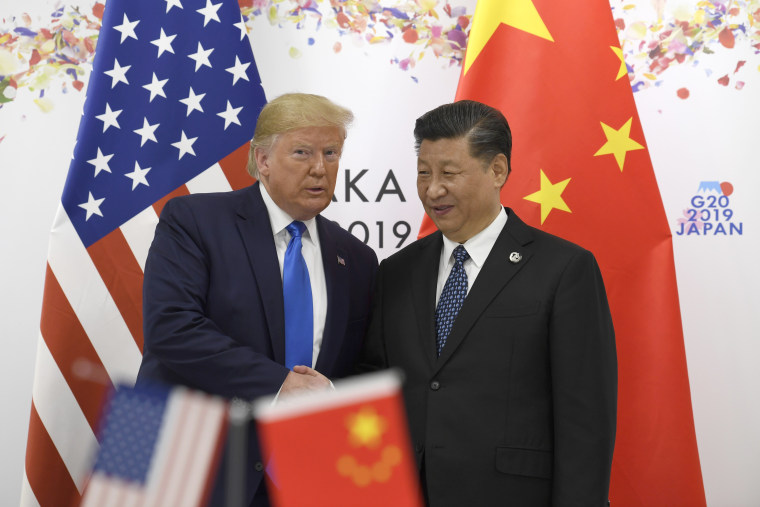OSAKA, Japan — President Donald Trump agreed Saturday to hold off on imposing new tariffs on China as the two countries relaunched stalled talks aimed at ending their trade war.
Trump also said he was lifting his ban on U.S. companies selling technology to Huawei, the Chinese telecom firm accused by the U.S. of surveillance for the Chinese government and posing a cyber-security threat.
However, the two countries did not reach a broader deal to resolve U.S. concerns about the firm and it appeared that a ban on U.S. companies buying technology from Huawei would remain in place.
Trump cast his meeting with Chinese President Xi Jinping on the sidelines of the Group of 20 economic summit in Osaka as a success, telling reporters that "we will be continuing to negotiate."
"We're right back on track and we'll see what happens," he added.
The president said that 25 percent tariffs he's already imposed on hundreds of billions in Chinese imports will stay "at least for the time being," but that he also would not proceed with a new $300 billion round of tariffs on Chinese goods that he'd threatened after earlier negotiations broke down.
"We're not doing that," Trump said. "We’re going to work with China on where we left off to see if we can make a deal."
China, in a statement carried by its official Xinhua news agency, said negotiations had been restarted “on the basis of equality and mutual respect,” adding, “The U.S. side said not to add new tariffs on Chinese exports.”
The averted tariffs remove a looming threat to the global economy — at least for now — but could also raise questions about what the U.S. received in return.
Trump said that even as talks are ongoing, China had agreed to start spending money on U.S. farmers, though he did not give specifics.
"We're going to give them a list of things we'd like them to buy," the president said.
Yet on Huawei, a thorny yet unrelated issue that has been dragged into the trade fight, the two economic powers still have a significant gap to bridge. Trump said the two countries would save the issue "for the very end."
Trump has already slapped a 25 percent tariff on $250 billion in Chinese goods to the dismay of global economists. Absent an off-ramp, Trump has also threatened 25 percent tariffs on another $300 billion in goods from China, though he softened that position slightly before his trip by saying the rate could possibly be 10 percent instead.
Whether trade talks would be relaunched and more tariffs avoided had been the key question overshadowing Trump’s trip to the annual G-20 summit. Although a senior Trump administration official said there were “absolutely no preconditions” for their meeting, the serious ramifications for the economy in both countries raised the stakes for some type of resolution or breakthrough, even if only partial.
"They would like to make a deal, I will tell you that," Trump said, adding that if one were achieved, it would be "historic."
Although Beijing and Washington appeared headed toward a deal in May, the U.S. blamed China for scuttling the talks by pulling back from concessions it had already agreed to make. As he started his meeting with Xi earlier Saturday, Trump alluded to the breakdown in restrained, diplomatic terms that suggested he was seeking to avoid calling out the Chinese leader publicly in hopes of salvaging prospects for renewed talks.
“I actually think we were very close and then something happened where it slipped a little bit," he said. "Now it’s getting a little closer.”


